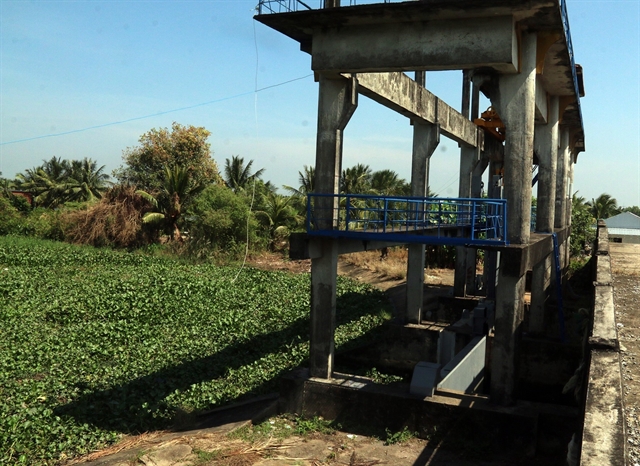 Environment
Environment


|
| A coastal culvert in Sơn Bình Commune, Hòn Đất District in Kiên Giang Province is used to prevent salinity and retain fresh water to serve agricultural production. — VNA/VNS Photo Lê Sen |
HÀ NỘI — Localities within the Cửu Long (Mekong) Delta are devising strategies to tackle the anticipated early onset of saltwater intrusion, projected to occur soon.
These strategies aim to secure adequate water for the winter-spring rice harvest and reduce the damage inflicted by drought and salinity.
The rainy season this year is predicted to have remained in the Mekong Delta only during the previous and the current month, concluding midway through next month.
Consequently, throughout the dry spell of this year and the next, the intrusion of saltwater is expected to appear a month sooner than the multi-year average, commencing in mid to late December.
Severe saltwater intrusion
Director of the Southern Institute of Water Resources Research (SIWRR) Trần Bá Hoằng said that the total rainfall this year was forecast to be about 1,350mm, only one per cent higher than 2015 (the year of severe drought), and about 13 per cent lower than the average of many years.
A fresh water shortage is forecast in an area of 66,000 hectares in Long An, Tiền Giang, Bến Tre, Trà Vinh and Sóc Trăng provinces.
Hoằng said that this year's rainy season was forecast to end early, so water shortage could occur in the 38,000-hectare rice and shrimp production area in Kiên Giang and Cà Mau provinces.
The two provinces should pay attention to additional water source solutions for aquaculture.
Meteorological experts predict that water levels in the lower Mekong River region this month will likely be 5-15 per cent higher than the average for many years, and next month will be 10-20 per cent lower compared to the average of many years in the same period.
From December this year to February next year, it will be 15-30 per cent lower than the average of many years.
In the 2023-24 winter-spring rice crop, the Mekong Delta region will sow nearly 1.5 million hectares with an expected output of more than 10 million tonnes.
The SIWRR defined that El Nino would likely last until the end of this year and into early next year.
Besides the above localities directly affected by saltwater intrusion, drought is likely to affect areas which are about 30-70km far from the sea.
If saltwater intrusion comes early and lasts for a long time with high salinity concentration, some areas along the Tiền and Hậu rivers in Vĩnh Long, Cần Thơ, Bến Tre and Tiền Giang provinces may experience saline drought for rice and orchards.
Nguyễn Hữu Thiện, an independent expert on the Mekong Delta ecosystem, said El Nino was happening but it was still unclear how strong it would be.
In case this year's El Nino is as strong as in 2015-16 and 2019-20, the drought and salinity situation early next year may be very severe, and saline intrusion will penetrate deep into coastal areas.
In the extreme El Nino, salinity prevention is only effective at the beginning of the dry season. By the middle of the dry season, from February next year and onwards, even if the people prevent saltwater intrusion, there will still be a lack of fresh water inland.
Experts predict that in the dry season months of 2023-24, the water level in the Mekong River upstream will be strongly influenced by tides.
Response solutions
Hoằng warned that 43,300 hectares of fruit trees in different provinces in the Mekong Delta could be affected.
Localities need to pay attention to storing water from the beginning of the dry season for use throughout the season.
The winter-spring crop of 2023-24 needs to be sown early, and should be basically finished by the end of this year.
The Cà Mau peninsula needs to build temporary dams and dredge canals before the end of the rainy season.
To avoid drought and saltwater intrusion, besides arranging reasonable crop schedules, people can also use short-term rice varieties.
Instead of using 110-day varieties, they can use 95-day or 100-day ones.
Deputy Director of Tiền Giang Department of Agriculture and Rural Development Trần Hoàng Nhật Nam said that the provincial agricultural sector would closely monitor and inspect water source quality, water level, salinity in canals and in fields.
It will provide regular information to people for timely response.
For fruit growing areas, Tiền Giang Province constructed six culverts connecting the Tiền River to ensure salinity prevention.
As for the eastern region, it plans that wherever salinity is, it will prevent salinity there.
In Đồng Tháp Province, water-saving rice cultivation models are being conducted.
Currently, the province has about 100 green agricultural models.
Experts believe that to overcome the El Nino challenge, an indispensable solution is to raise people's awareness of the risks and impacts of saltwater intrusion.
Deputy Director of the Bến Tre Department of Agriculture and Rural Development Bùi Văn Thắm said that the province has flexibly coordinated with districts and cities to train local people about natural disaster prevention and control.
Information and guidance on natural disaster prevention and response are being broadcast on mass media. — VNS




